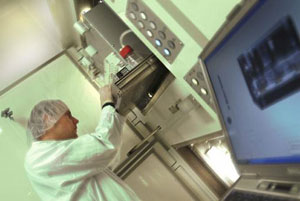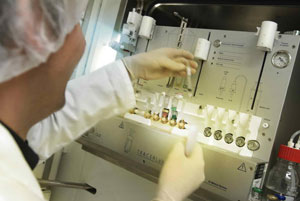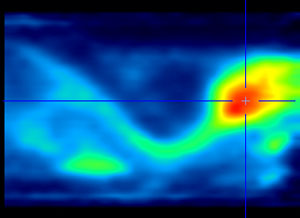
Ephoran Multi Imaging Solutions Preclinical Services is a contract research organization (CRO) located in the Bio Industry Park of Canavese at Colleretto Giacosa (Torino, Italy), offering pre-clinical imaging services and , within the collaboration with the shareholder Advanced Accelerator Applications (AAA), the on-demand production of PET and SPECT tracers. Originated as a spin-off of the European Organization for Nuclear Research (CERN, the world's largest research laboratory for particle physics) of Geneva, AAA is currently focusing on applying its core competences and skills in physics, chemistry and pharmacy to develop and commercialise innovative products and technologies in Nuclear Medicine with particular emphasis on PET (Positron Emission Tomography) diagnostics and cancer therapy. PET scanning is an emerging technology for the clinical evaluation of many disease processes in man. Most of the clinical positron emission tomography (PET) studies are performed using a single tracer, fluorodeoxyglucose (FDG) . AAA first commercial product is GluscanŽ (FluoroDeoxyGlucose or FDG), a injectable solution used for PET diagnostics (Positron Emission Tomography), registered in France, Italy, Belgium, Luxemburg and Switzerland.  Despite the excellent diagnostic performance of this tracer, new tracers offer the potential to both address FDG limitations, and to establish new applications for PET. Small animal PET and SPECT are the techniques for validating new tracers in order to evaluate if are relevant to human diseases. Application of a systematic approach to tracer development is likely to speed transition of new tracers from animals into man. The process of developing new tracers for human use is complex follows some major steps starting from the definition of clinical need, to the establishment of an appropriate pre-clinical model for testing , and to the documentation of safety and efficacy. Whereas the design and production of new tracers starts from the identification of an appropriate target , to the selection of precursor ligands and the development of labelling strategies, to the optimisation of labelling. Increasing understanding of molecular biology enables identification of novel potential targets for the diagnosis and treatment of diseases. Small animal PET and SPECT are being increasingly used by academic institutions and pharmaceutical companies as a platform technology for translational research and drug development.
Despite the excellent diagnostic performance of this tracer, new tracers offer the potential to both address FDG limitations, and to establish new applications for PET. Small animal PET and SPECT are the techniques for validating new tracers in order to evaluate if are relevant to human diseases. Application of a systematic approach to tracer development is likely to speed transition of new tracers from animals into man. The process of developing new tracers for human use is complex follows some major steps starting from the definition of clinical need, to the establishment of an appropriate pre-clinical model for testing , and to the documentation of safety and efficacy. Whereas the design and production of new tracers starts from the identification of an appropriate target , to the selection of precursor ligands and the development of labelling strategies, to the optimisation of labelling. Increasing understanding of molecular biology enables identification of novel potential targets for the diagnosis and treatment of diseases. Small animal PET and SPECT are being increasingly used by academic institutions and pharmaceutical companies as a platform technology for translational research and drug development.  The ability to extrapolate from animals to human studies make PET and SPECT techniques for both pre-clinical testing of new therapeutic drugs and for the validation of new tracers that might be relevant to the evaluation of human diseases. Development of appropriate animal models for testing targeted tracers is an important step in this process. Due to the favourable imaging characteristics and ready availability of fluorine-18, there has been an increasing focus on fluorinated tracers. In AAA, a wide range of both cyclotron and generator produced isotopes are available including gallium-68 and iodine-124 for PET and indium -111 for SPECT. These tracers lend themselves to complexing with biological macromolecules, such as peptides and antibodies. The availability of long-lived positron emitting radionuclides offers particular opportunities for translational research in the labelling of larger molecular species, including monoclonal antibodies, which can have slow accumulation in tissues. Within the Ephoran services , the availability of PET/SPECT imagers for preclinical small animals examinations close to site of production of AAA guarantee for a rapid use of the new tracers in animal models resembling different human diseases.
The ability to extrapolate from animals to human studies make PET and SPECT techniques for both pre-clinical testing of new therapeutic drugs and for the validation of new tracers that might be relevant to the evaluation of human diseases. Development of appropriate animal models for testing targeted tracers is an important step in this process. Due to the favourable imaging characteristics and ready availability of fluorine-18, there has been an increasing focus on fluorinated tracers. In AAA, a wide range of both cyclotron and generator produced isotopes are available including gallium-68 and iodine-124 for PET and indium -111 for SPECT. These tracers lend themselves to complexing with biological macromolecules, such as peptides and antibodies. The availability of long-lived positron emitting radionuclides offers particular opportunities for translational research in the labelling of larger molecular species, including monoclonal antibodies, which can have slow accumulation in tissues. Within the Ephoran services , the availability of PET/SPECT imagers for preclinical small animals examinations close to site of production of AAA guarantee for a rapid use of the new tracers in animal models resembling different human diseases.
